Effect of Biochar from Oat Hulls on the Physical Properties of Asphalt Binder
Abstract
1. Introduction
2. Materials and Methods
2.1. Materials
2.2. Asphalt Binder Modification Procedure
2.3. Experimental Plan
2.4. Test Methods
2.4.1. Physicochemical Characterization of Raw Materials and Samples
2.4.2. Evaluation of the Physical Properties of Modified Asphalt
- Iagr = aging rate of the asphalt binder,
- RVRTFOT = rotational viscosity of the asphalt binder aged by RTFOT (poises),
- Voriginal = rotational viscosity of the asphalt binder in original state (poises).
- PI = penetration index of the asphalt binder,
- Pen = result of the penetration test at 25 °C,
- SP = result of the softening point test using the ring and ball apparatus.
3. Results
3.1. Physicochemical Characterization of Raw Materials and Samples
3.1.1. Scanning Electron Microscopy (Sem) and Energy Dispersive X-ray Spectroscopy (EDS)
3.1.2. Confocal (Fluorescence) Laser Microscopy
3.1.3. Fourier Transform Infrared Spectroscopy (FTIR)
3.2. Analysis of Physical Properties of Modified Asphalt
3.2.1. Rotational Viscosity (RV)
3.2.2. Aging Index (Iagr)
3.2.3. The Fraass Breaking Point vs. the Softening Point (SP)
3.2.4. The Penetration (Pen)
3.2.5. Penetration Index (PI)
3.2.6. Storage Stability
4. Discussion
- It is determined that the asphalt binder and BO interact positively due to C=O and C=C bonds of the functional groups present on the surface of both materials.
- It is shown that the BO can be distributed homogenously in the asphalt matrix, in all the addition percentages considered, without causing clusters.
- The rotational viscosity of the asphalt binder in the original and short-term aged states increased with the addition of BO. This increase was directly proportional to the amount of BO added to the asphalt binder.
- The resistance to aging of the asphalt binder was maintained with the addition of BO. The values obtained for the parameter of aging of the modifications evaluated were lower than the regulatory requirements.
- The viscoelastic range of the asphalt binder can be extended with the addition of BO, being proportional to the increase in the modifying content, and being able to reduce the thermal susceptibility of the asphalt binder.
- The use of BO increases the consistency at an intermediate temperature, reducing the penetration of the asphalt binder.
- The reduction of the penetration, the increase in the softening point and the increase in viscosity demonstrate that BO improves the performance-related properties of the asphalt binder at high temperatures.
- With up to 7.5% modification with BO, good storage stability of the asphalt binder is obtained.
- Future studies are suggested to assess the effect of different PTT and residence times on the properties of the BO as a modifying additive. In addition, the effect of a smaller particle size and the effect of an additional digestion time after the asphalt binder modification stage should also be evaluated.
5. Conclusions
Author Contributions
Funding
Institutional Review Board Statement
Informed Consent Statement
Data Availability Statement
Conflicts of Interest
References
- Gan, X.; Zhang, W. Application of biochar from crop straw in asphalt modification. PLoS ONE 2021, 16, e0247390. [Google Scholar] [CrossRef] [PubMed]
- Holý, M.; Remišová, E. Characterization of Bitumen Binders on the Basis of Their Thermo-Viscous Properties. Slovak J. Civ. Eng. 2019, 27, 25–31. [Google Scholar] [CrossRef]
- Abed, Y.H.; Al-Haddad, A.H.A. Temperature Susceptibility of Modified Asphalt Binders. IOP Conf. Series Mater. Sci. Eng. 2020, 671, 012121. [Google Scholar] [CrossRef]
- Behnood, A.; Gharehveran, M.M. Morphology, rheology, and physical properties of polymer-modified asphalt binders. Eur. Polym. J. 2019, 112, 766–791. [Google Scholar] [CrossRef]
- Mamun, A. Arifuzzaman Nano-scale moisture damage evaluation of carbon nanotube-modified asphalt. Constr. Build. Mater. 2018, 193, 268–275. [Google Scholar] [CrossRef]
- Yang, Q.; Li, X.; Zhang, L.; Qian, Y.; Qi, Y.; Kouhestani, H.S.; Shi, X.; Gui, X.; Wang, D.; Zhong, J. Performance evaluation of bitumen with a homogeneous dispersion of carbon nanotubes. Carbon 2020, 158, 465–471. [Google Scholar] [CrossRef]
- Moreno-Navarro, F.; Sol-Sánchez, M.; Gámiz, F.; Rubio-Gámez, M. Mechanical and thermal properties of graphene modified asphalt binders. Constr. Build. Mater. 2018, 180, 265–274. [Google Scholar] [CrossRef]
- Leiva-Villacorta, F.; Aguiar-Moya, J.; Villegas, R.; Salazar, J.; Loría-Salazar, L. Nano-Materiales En El Desempeño Del Asfalto; Laboratorio Nacional de Materiales y Modelos Estructurales Lanamme UCR: San José, Costa Rica, 2014; p. 10. [Google Scholar]
- Calderón, C. Vías Más Duraderas Gracias a Los Nanomateriales. 2018. Available online: https://www.javeriana.edu.co/pesquisa/vias-mas-duraderas-gracias-a-los-nanomateriales/ (accessed on 12 May 2021).
- Vicente Pérez, J.; Pérez Infante, J.I.; García, A.; Baselga Llidó, J.; Agzenai Ben Salem, Y.; Pozuelo de Diego, J.; Sanz Feito, J. Mezclas asfálticas con betunes modificados con nanotubos de carbono. Diseño y propiedades. Carreteras 2016, 4, 20–30. [Google Scholar]
- Themeli, A.; Chailleux, E.; Farcas, F.; Chazallon, C.; Migault, B.; Buisson, N. Molecular structure evolution of asphaltite-modified bitumens during ageing; Comparisons with equivalent petroleum bitumens. Int. J. Pavement Res. Technol. 2017, 10, 75–83. [Google Scholar] [CrossRef]
- Pan, P.; Wu, S.; Xiao, Y.; Wang, P.; Liu, X. Influence of graphite on the thermal characteristics and anti-ageing properties of asphalt binder. Constr. Build. Mater. 2014, 68, 220–226. [Google Scholar] [CrossRef]
- Seyrek, E.; Yalçin, E.; Yilmaz, M.; Kök, B.V.; Arslanoğlu, H. Effect of activated carbon obtained from vinasse and marc on the rheological and mechanical characteristics of the bitumen binders and hot mix asphalts. Constr. Build. Mater. 2020, 240, 117921. [Google Scholar] [CrossRef]
- Zhao, S.; Huang, B.; Ye, X.P.; Shu, X.; Jia, X. Utilizing bio-char as a bio-modifier for asphalt cement: A sustainable application of bio-fuel by-product. Fuel 2014, 133, 52–62. [Google Scholar] [CrossRef]
- Bekchanova, M.; Campion, L.; Bruns, S.; Kuppens, T.; Jozefczak, M.; Cuypers, A.; Malina, R. Biochar’s effect on the ecosystem services provided by sandy-textured and contaminated sandy soils: A systematic review protocol. Environ. Évid. 2021, 10, 7. [Google Scholar] [CrossRef]
- Głąb, T.; Gondek, K.; Mierzwa–Hersztek, M. Biological effects of biochar and zeolite used for remediation of soil contaminated with toxic heavy metals. Sci. Rep. 2021, 11, 6998. [Google Scholar] [CrossRef]
- Gupta, S.; Kua, H.W.; Low, C.Y. Use of biochar as carbon sequestering additive in cement mortar. Cem. Concr. Compos. 2018, 87, 110–129. [Google Scholar] [CrossRef]
- Lee, J.; Hawkins, B.; Day, D.; Reicosky, D.C. Sustainability: The capacity of smokeless biomass pyrolysis for energy production, global carbon capture and sequestration. Energy Environ. Sci. 2010, 3, 1695–1705. [Google Scholar] [CrossRef]
- Woolf, D.; Amonette, J.E.; Street-Perrott, F.A.; Lehmann, J.; Joseph, S.G. Sustainable biochar to mitigate global climate change. Nat. Commun. 2010, 1, 56. [Google Scholar] [CrossRef]
- Roberts, K.G.; Gloy, B.A.; Joseph, S.; Scott, N.R.; Lehmann, J. Life Cycle Assessment of Biochar Systems: Estimating the Energetic, Economic, and Climate Change Potential. Environ. Sci. Technol. 2010, 44, 827–833. [Google Scholar] [CrossRef]
- Zhang, R.; Dai, Q.; You, Z.; Wang, H.; Peng, C. Rheological Performance of Bio-Char Modified Asphalt with Different Particle Sizes. Appl. Sci. 2018, 8, 1665. [Google Scholar] [CrossRef]
- Zhang, R.; Wang, H.; Ji, J.; Wang, H. Viscoelastic Properties, Rutting Resistance, and Fatigue Resistance of Waste Wood-Based Biochar-Modified Asphalt. Coatings 2022, 12, 89. [Google Scholar] [CrossRef]
- Gonzalez, M.E.; Gonzalez, A.; Toro, C.; Cea, M.; Sepulveda, N.; Díez, M.C.; Navia, R. Biochar as a Renewable Matrix for the Development of Encapsulated and Immobilized Novel Added-Value Bioproducts. J. Biobased Mater. Bioenergy 2012, 6, 237–248. [Google Scholar] [CrossRef]
- Brown, T.R.; Wright, M.M.; Brown, R.C. Estimating profitability of two biochar production scenarios: Slow pyrolysis vs fast pyrolysis. Biofuels Bioprod. Biorefining 2011, 5, 54–68. [Google Scholar] [CrossRef]
- Babel, S.; Kurniawan, T.A. Low-cost adsorbents for heavy metals uptake from contaminated water: A review. J. Hazard. Mater. 2003, 97, 219–243. [Google Scholar] [CrossRef]
- US Geological Survey. Mineral Commodity, Summaries 2005. 2005. Available online: http://minerals.usgs.gov/minerals/pubs/mcs/2005/mcs2005.pdf (accessed on 12 August 2022).
- Alexander, H.; Reyes-lizcano, F.A.; Baudilio, S.; Gabriel, J.; Alfonso, C. Use of Biochar in Asphalts: Review. Sustainability 2022, 14, 4745. [Google Scholar] [CrossRef]
- González, M.E.; Cea, M.; Sangaletti, N.; González, A.; Toro, C.; Diez, M.C.; Moreno, N.; Querol, X.; Navia, R. Biochar Derived from Agricultural and Forestry Residual Biomass: Characterization and Potential Application for Enzymes Immobilization. J. Biobased Mater. Bioenergy 2013, 7, 724–732. [Google Scholar] [CrossRef]
- González, M.E.; Romero-Hermoso, L.; Hidalgo, P.; Meier, S.; Navia, R.; Cea, M. Effects of Pyrolysis Conditions on Physicochemical Properties of Oat Hull Derived Biochar. BioResources 2017, 12, 2040–2057. [Google Scholar] [CrossRef]
- ODEPA. El Mercado De La Avena Blanca En Chile. 2017. Available online: https://www.odepa.gob.cl/wp-content/uploads/2017/12/Avena.pdf (accessed on 13 August 2022).
- ICIgroup. Ficha Técnica De Producto Avena Entera Con Cáscara. 2013, p. 9. Available online: http://icigroup.gt/wp-content/fichas/Avena_Entera_con_cascara.pdf (accessed on 8 February 2021).
- Dirección de Vialidad de Chile. Volumen 8. Especificaciones y métodos de muestreo, ensaye y control. In Manual de Carreteras; Ministerio de Obras Publicas de Chile, Ed.; Ministerio de Obras Públicas: Santiago, Chile, 2021. [Google Scholar]
- Hunter, R.N.; Self, A.; Read, J. The Shell Bitumen Handbook, 6th ed.; Shell Bitumen: London, UK, 2015. [Google Scholar]
- Lesueur, D. The colloidal structure of bitumen: Consequences on the rheology and on the mechanisms of bitumen modification. Adv. Colloid Interface Sci. 2009, 145, 42–82. [Google Scholar] [CrossRef]
- Ma, F.; Dai, J.; Fu, Z.; Li, C.; Wen, Y.; Jia, M.; Wang, Y.; Shi, K. Biochar for asphalt modification: A case of high-temperature properties improvement. Sci. Total Environ. 2022, 804, 150194. [Google Scholar] [CrossRef]
- Khiavi, A.K.; Ghanbari, A.; Ahmadi, E. Physical and High-Temperature Rheological Properties of PHEMA-Modified Bitumen. J. Mater. Civ. Eng. 2020, 32, 4020010. [Google Scholar] [CrossRef]
- Ertugrul, M.; Mehmet, Y.; Kök, B.V.; Yalçin, E. Effects of various biochars on the high temperature performance of bituminous binder. 2017. Available online: https://www.researchgate.net/publication/312326052_Effects_of_various_biochars_on_the_high_temperature_performance_of_bituminous_binder (accessed on 13 August 2022).
- Walters, R.C.; Fini, E.H.; Abu-Lebdeh, T. Enhancing asphalt rheological behavior and aging susceptibility using bio-char and nano-clay. Am. J. Eng. Appl. Sci. 2014, 7, 66–76. [Google Scholar] [CrossRef]
- Dong, W.; Ma, F.; Li, C.; Fu, Z.; Huang, Y.; Liu, J. Evaluation of Anti-Aging Performance of Biochar Modified Asphalt Binder. Coatings 2020, 10, 1037. [Google Scholar] [CrossRef]
- Wen, G.; Zhang, Y.; Zhang, Y.; Sun, K.; Fan, Y. Improved properties of SBS-modified asphalt with dynamic vulcanization. Polym. Eng. Sci. 2002, 42, 1070–1081. [Google Scholar] [CrossRef]
- Al-Layla, M.M.; Hussien, A.K.; Mjthab, E.I. Evaluation of the properties and storage stability of EVA polymer modified asphalt. J. Educ. Sci. 1999, 24, 14–20. [Google Scholar] [CrossRef]
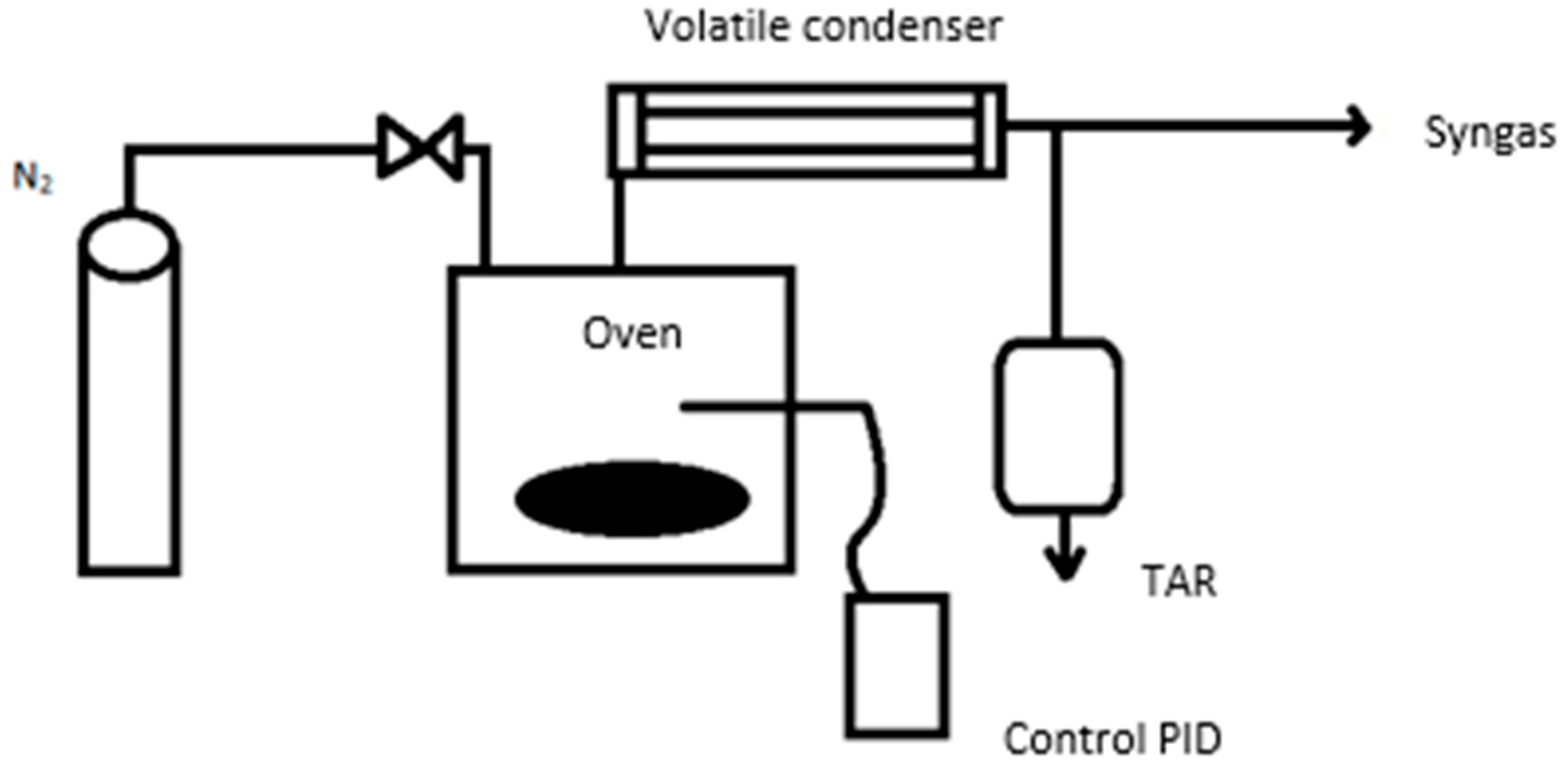

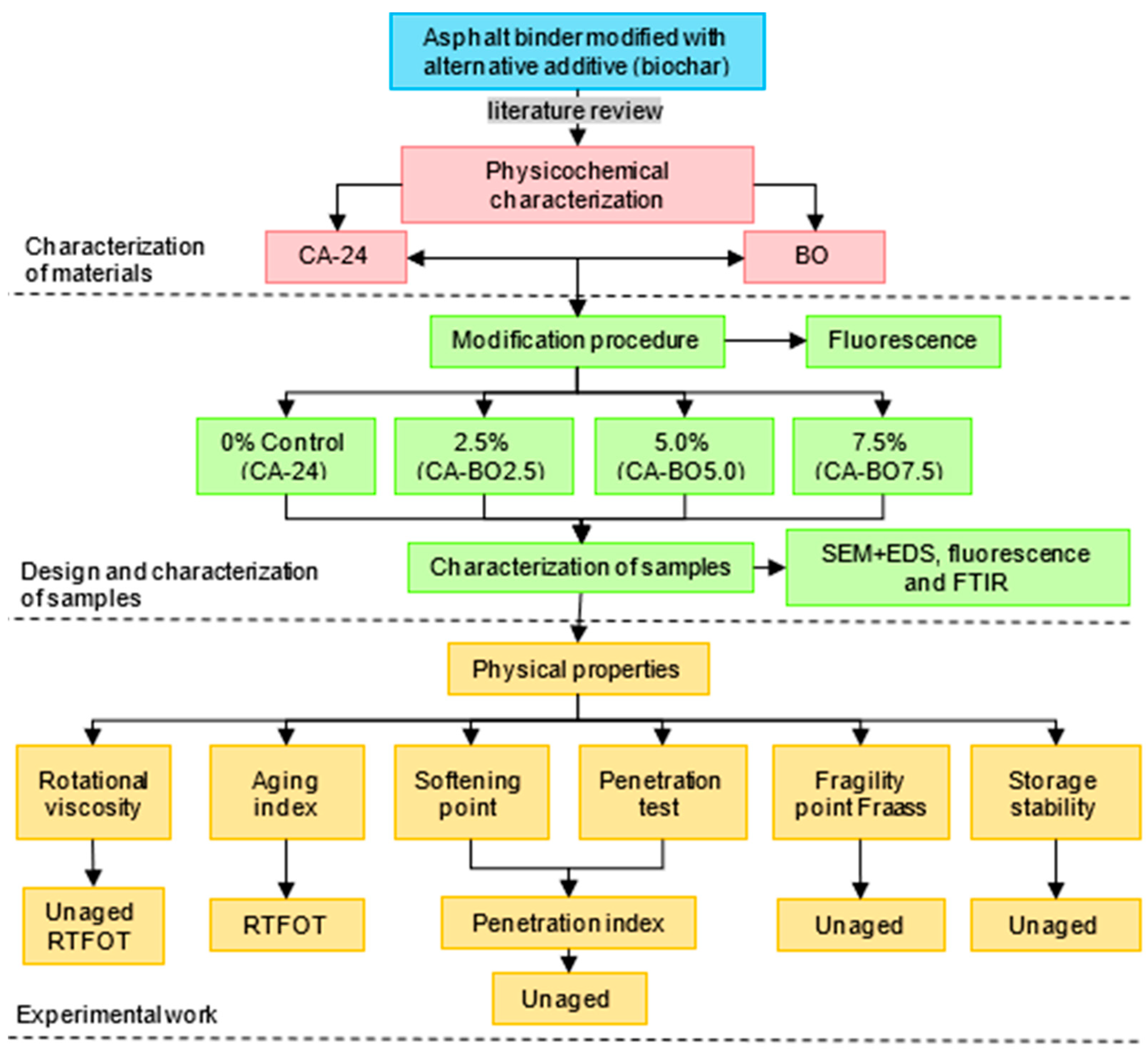
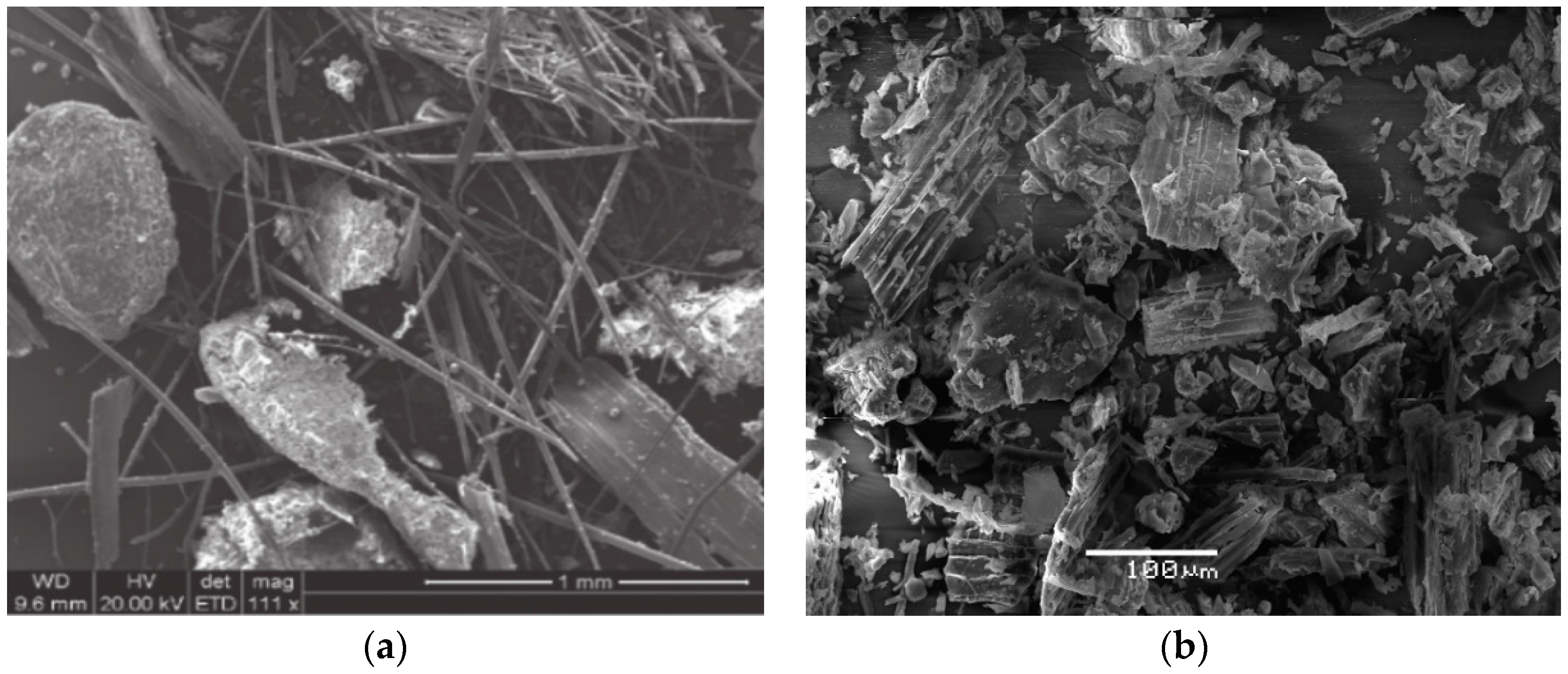
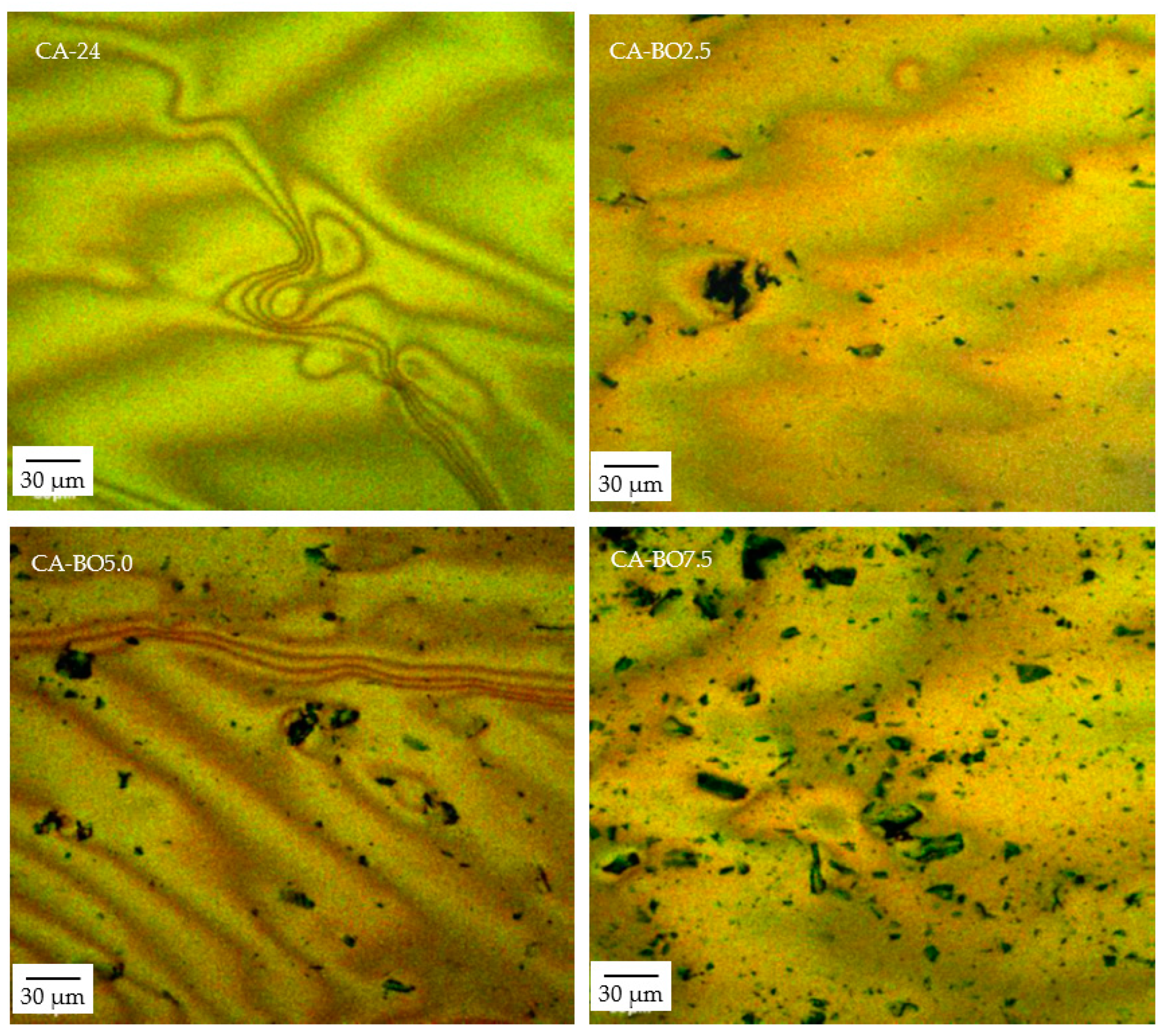




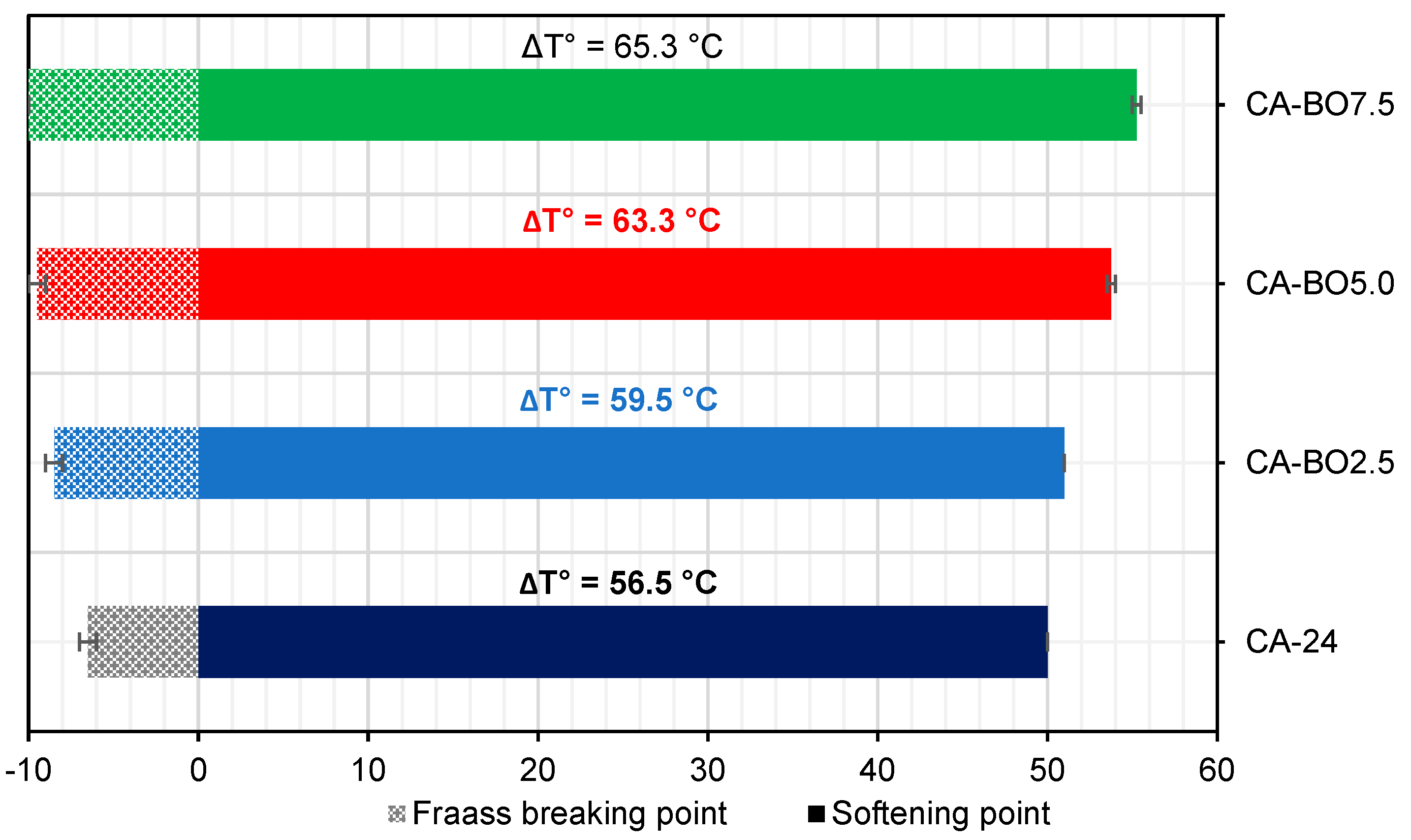

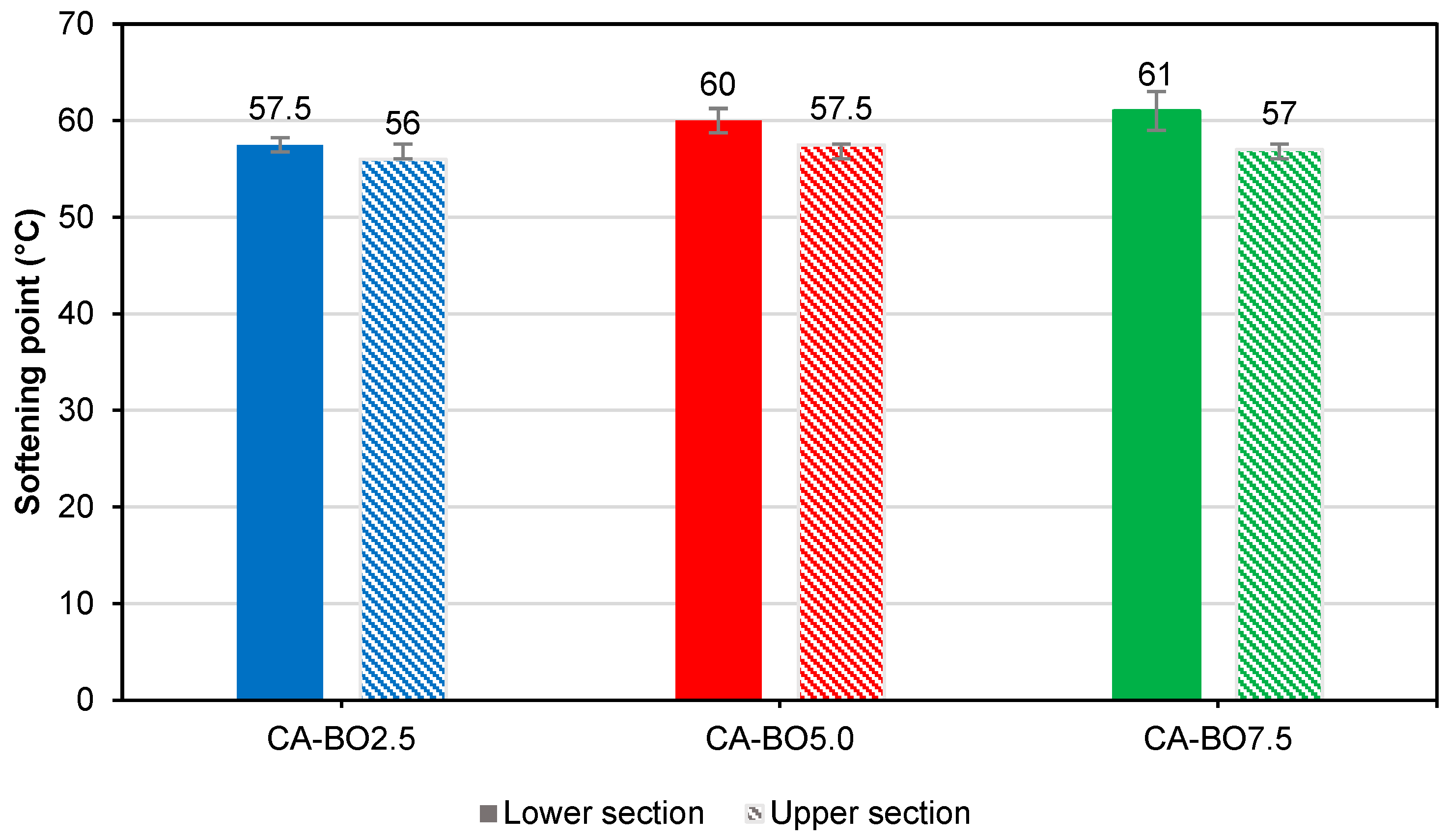

| Tests | Specs. [32] | CA-24 |
|---|---|---|
| Original viscosity at 60 °C (P) | Min. 2400 | 2940 |
| Penetration at 25 °C, 100 g, 5 s (dmm) | Min. 40 | 63 |
| Ductility at 25 °C, 5 cm/min (cm) | Min. 100 | 100 |
| Trichloroethylene solubility (%) | Min. 99 | 99.8 |
| Flash point (°C) | Min. 232 | 310 |
| Softening point (°C) | - | 52.2 |
| Penetration index | −1.0 to + 1.0 | −0.1 |
| RTFOT | ||
| Mass loss (%) | Max. 0.8 | 0.08 |
| Viscosity at 60 °C (P) | - | 7860 |
| Ductility at 25 °C, 5 cm/min (cm) | Min. 100 | 100 |
| Durability index | Max. 3.5 | 2.7 |
| IP Value | Description |
|---|---|
| PI > +1 | Asphalts that are not very susceptible to temperature and show non-Newtonian flow behavior, with certain elasticity and thixotropy. |
| PI < −1 | Asphalts that are highly susceptible to temperature and exhibit Newtonian flow behavior. |
| −1 < PI < +1 | Asphalts that have rheological and flow characteristics intermediate between the two previous cases. Most of the asphalt binder used in paving has these characteristics. |
| Chemical Element | BO | CA-24 | CA-BO2.5 | CA-BO5.0 | CA-BO7.5 | |||||
|---|---|---|---|---|---|---|---|---|---|---|
| Content (%) | σ | Content (%) | σ | Content (%) | σ | Content (%) | σ | Content (%) | σ | |
| Carbon (C) | 70.51 | 3.09 | 92.60 | 3.93 | 91.39 | 3.13 | 86.54 | 8.39 | 87.03 | 5.10 |
| Sulfur (S) | - | - | 3.80 | 0.15 | 3.36 | 0.26 | 3.08 | 1.60 | 3.58 | 0.64 |
| Oxygen (O) | 22.72 | 0.48 | 2.92 | 1.69 | 3.82 | 2.95 | 8.24 | 6.73 | 5.16 | 4.01 |
| Calcium (Ca) | 1.38 | 0.29 | - | - | 0.67 | 0.39 | - | - | - | - |
| Nitrogen (N) | - | - | 7.87 | 4.54 | - | - | 4.31 | 2.49 | 7.35 | 4.24 |
| Silicon (Si) | 3.29 | 3.25 | - | - | - | - | 1.62 | 0.96 | - | - |
| Potassium (K) | 1.89 | 0.53 | - | - | - | - | - | - | 3.51 | 2.03 |
| Phosphorus (P) | 0.61 | 0.35 | - | - | - | - | - | - | 1.22 | 0.70 |
| Sample | CA-24 | CA-BO2.5 | CA-BO5.0 | CA-BO7.5 |
|---|---|---|---|---|
| Penetration index | −0.7 | −0.8 | −0.6 | −0.3 |
Publisher’s Note: MDPI stays neutral with regard to jurisdictional claims in published maps and institutional affiliations. |
© 2022 by the authors. Licensee MDPI, Basel, Switzerland. This article is an open access article distributed under the terms and conditions of the Creative Commons Attribution (CC BY) license (https://creativecommons.org/licenses/by/4.0/).
Share and Cite
Martínez-Toledo, C.; Valdés-Vidal, G.; Calabi-Floody, A.; González, M.E.; Reyes-Ortiz, O. Effect of Biochar from Oat Hulls on the Physical Properties of Asphalt Binder. Materials 2022, 15, 7000. https://doi.org/10.3390/ma15197000
Martínez-Toledo C, Valdés-Vidal G, Calabi-Floody A, González ME, Reyes-Ortiz O. Effect of Biochar from Oat Hulls on the Physical Properties of Asphalt Binder. Materials. 2022; 15(19):7000. https://doi.org/10.3390/ma15197000
Chicago/Turabian StyleMartínez-Toledo, Camila, Gonzalo Valdés-Vidal, Alejandra Calabi-Floody, María Eugenia González, and Oscar Reyes-Ortiz. 2022. "Effect of Biochar from Oat Hulls on the Physical Properties of Asphalt Binder" Materials 15, no. 19: 7000. https://doi.org/10.3390/ma15197000
APA StyleMartínez-Toledo, C., Valdés-Vidal, G., Calabi-Floody, A., González, M. E., & Reyes-Ortiz, O. (2022). Effect of Biochar from Oat Hulls on the Physical Properties of Asphalt Binder. Materials, 15(19), 7000. https://doi.org/10.3390/ma15197000








